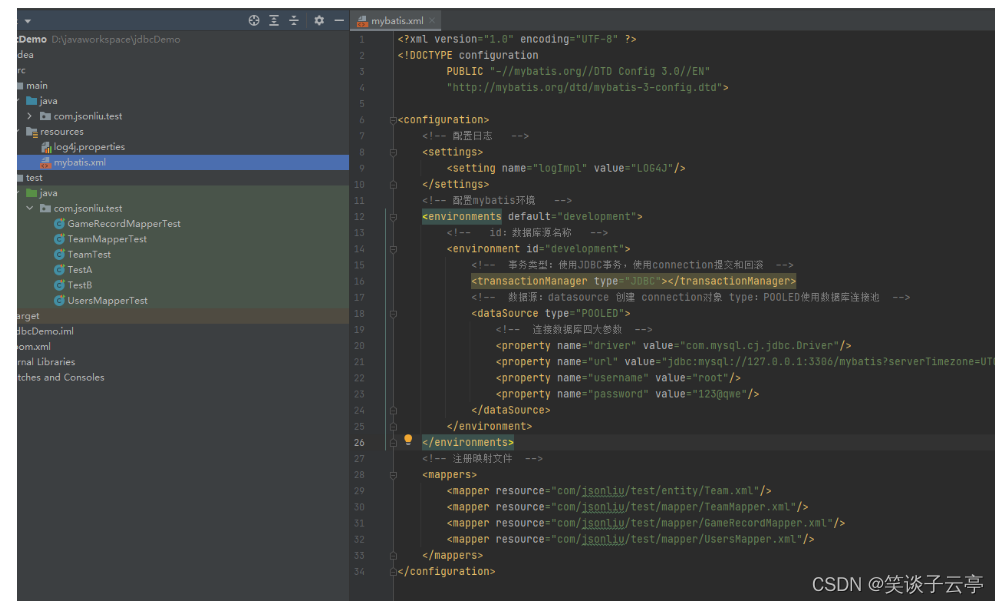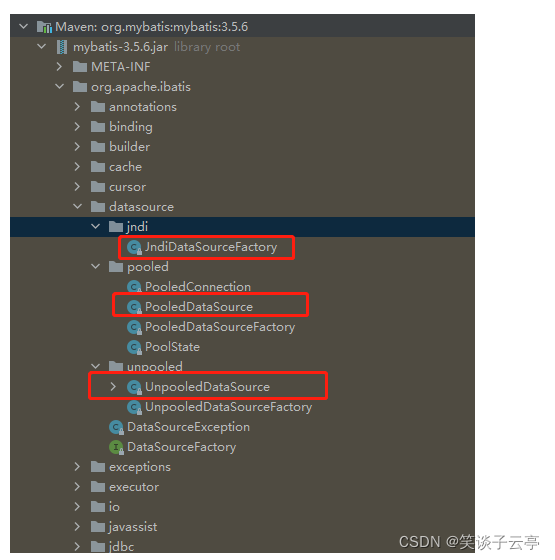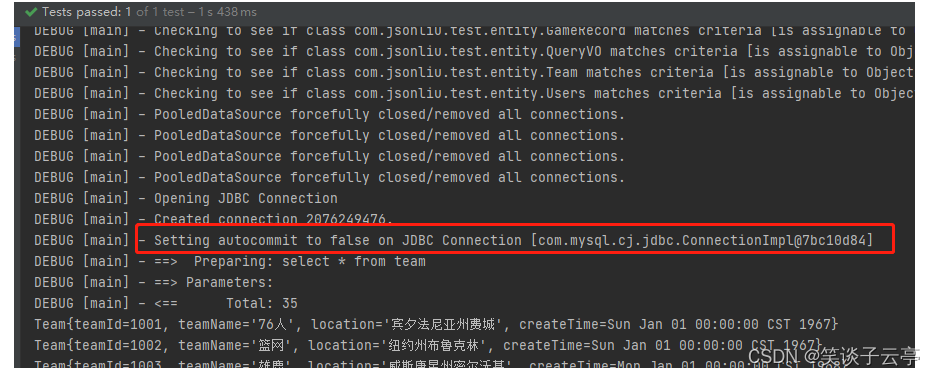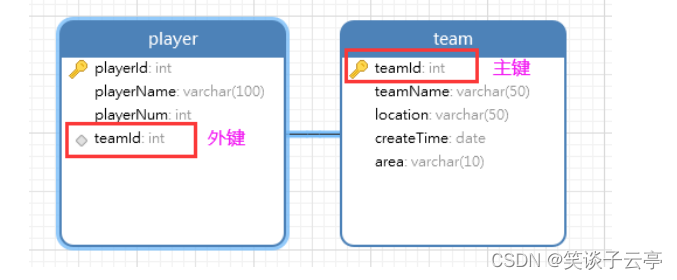Mybatis全局配置及映射关系的实现
作者:笑谈子云亭
一、配置文件内容
mybatis.xml就是Mybatis的全局配置文件。

全局配置文件需要在头部使用约束文件。
<?xml version="1.0" encoding="UTF-8" ?>
<!DOCTYPE configuration
PUBLIC "-//mybatis.org//DTD Config 3.0//EN"
"http://mybatis.org/dtd/mybatis-3-config.dtd">
配置文件的顶层结构如下:
configuration(配置)
properties--属性:加载外部配置文件,例如数据库的连接信息
Settings--全局配置参数:例如日志配置
typeAliases--类型别名
typeHandlers--类型处理器
objectFactory--对象工厂
Plugins--插件:例如分页插件
Environments--环境集合属性对象
environment(环境变量)
transactionManager(事务管理器)
dataSource(数据源)
Mappers--映射器:注册映射文件
1.1、Proerties
属性可以在外部配置,并可以进行动态替换。我们既可以在properties元素的子元素设置(例如Datasource中的properties节点)也可以在java属性文件中配置。
数据源中有连接数据库的四个参数数据,我们一般都放在专门的属性文件中,mybatis的全局配置文件直接从属性文件中读取数据。
1、resources目录下创建jdbc.properties
jdbc.driver=com.mysql.cj.jdbc.Driver jdbc.url=jdbc:mysql://127.0.0.1:3306/mybatis?serverTimezone=UTC&characterEncoding=utf-8&serverTimezone=Asia/Shanghai jdbc.username=root jdbc.password=123@qwe
2、mybatis.xml中引入配置文件
<properties resource="jdbc.properties"/>
3、使用属性文件中的值
<dataSource type="POOLED">
<!-- 连接数据库四大参数 -->
<property name="driver" value="${jdbc.driver}"/>
<property name="url" value="${jdbc.url}"/>
<property name="username" value="${jdbc.username}"/>
<property name="password" value="${jdbc.password}"/>
</dataSource>
1.2、设置setting
Mybatis中极为重要的调整设置,它们会改变Mybatis的运行行为,例如日志。
<!-- 配置日志 -->
<settings>
<setting name="logImpl" value="LOG4J"/>
</settings>
1.3、类型别名typeAliases
可以为java类型设置一个缩写别名,仅用于xml配置,意在减低冗余全限定类名书写。
MyBatis中已经支持一些常见类型的别名,如下:
| 别名 | 映射的类型 |
|---|---|
| _byte | byte |
| _long | long |
| _short | short |
| _int | int |
| _integer | int |
| _double | double |
| _float | float |
| _boolean | boolean |
| string | String |
| byte | Byte |
| long | Long |
| short | Short |
| int | Integer |
| integer | Integer |
| double | Double |
| float | Float |
| boolean | Boolean |
| date | Date |
| decimal | BigDecimal |
| bigdecimal | BigDecimal |
| object | Object |
| map | Map |
| hashmap | HashMap |
| list | List |
| arraylist | ArrayList |
| collection | Collection |
| iterator | Iterator |
也支持自定义别名:
<typeAliases>
<!-- 对单个实体类定义别名 -->
<typeAlias type="com.jsonliu.test.entity.Users" alias="Users" />
<!-- 推荐:批量定义别名,扫描指定包下所有类,同时别名定义为类名,别名首字母大小写都可以 -->
<package name="com.jsonliu.test.entity"/>
</typeAliases>
1.4、映射器Mappers
1.4.1、使用相对于类路径的资源引用
语法:<mapper resource="">
使用相对于类路径的资源,从classpath路径查找文件
例如:<mapper resource="com/jsonliu/test/entity/Team.xml"/>
1.4.2、使用映射器接口实现类的完全限定类名
语法:<mapper class="">
要求:接口和映射文件同包同名
<mapper class="com.jsonliu.test.mapper.UsersMapper"/>
1.4.3、将包内映射器接口全部注册为映射器
推荐
语法:<package name="">
指定包下的所有mapper接口
例如:<package name="com.jsonliu.test.mapper"/>
注意:此种方法要求Mapper接口名称和mapper映射文件名称相同,且在同一个目录中
1.5、dataSource
Mybatis中访问数据库支持连接池技术,而且采用的自己的连接池技术。在mybatis.xml文件中进行配置,根据type属性创建相应类型数据源DataSource。
Mybatis数据源分三类:
- UNPOOLED:不使用连接池数据源
- POOLED:使用连接池数据源
- JNDI:使用JNDI实现的数据源
前两个数据源都实现了javax.sql.Datasource接口

1.6、事务
默认手动提交事务:
Mybatis框架是对JDBC的封装,所以Mybatis事务的控制方式本身也是用JDBC的connection对象的commit()、rollback()方法,connection对象的setAutoCommit()设置事务提交方式为手动或者自动。
<!-- 事务类型:使用JDBC事务,使用connection提交和回滚 -->
<transactionManager type="JDBC" />
transactionManager 指定Mybatis所用事务管理器,支持:JDBC与MANAGED
JDBC事务管理机制,通过Connection对象的commit()方法提交,rollback()方法回滚。默认情况下Mybatis将关闭自动提交功能,观察日志可以看出,提交或者回滚都需要我们手动设置。

MANAGED:由容器来管理事务的整个生命周期(如Spring容器)
SqlSessionFactory的openSession()方法存在重载,可以设置自动提交方式。
如果sqlSession = SqlSessionFactory.openSession(true);
参数设置为true,再次执行增删改不需要执行sqlSession.commit(),事务会自动提交。
二、Mybatis中的关系映射
表结构如下:

2.1、一对一映射
添加实体类Player:
public class Player {
private Integer playerId;
private String playerName;
private Integer playerNum;
private Integer teamId;
private Team team1;
public Player() {
}
public Player(Integer playerId, String playerName, Integer playerNum, Integer teamId) {
this.playerId = playerId;
this.playerName = playerName;
this.playerNum = playerNum;
this.teamId = teamId;
}
@Override
public String toString() {
return "Player{" +
"playerId=" + playerId +
", playerName='" + playerName + '\'' +
", playerNum=" + playerNum +
", teamId=" + teamId +
", team1=" + team1 +
'}';
}
public Integer getPlayerId() {
return playerId;
}
public void setPlayerId(Integer playerId) {
this.playerId = playerId;
}
public String getPlayerName() {
return playerName;
}
public void setPlayerName(String playerName) {
this.playerName = playerName;
}
public Integer getPlayerNum() {
return playerNum;
}
public void setPlayerNum(Integer playerNum) {
this.playerNum = playerNum;
}
public Integer getTeamId() {
return teamId;
}
public void setTeamId(Integer teamId) {
this.teamId = teamId;
}
public Team getTeam1() {
return team1;
}
public void setTeam1(Team team1) {
this.team1 = team1;
}
}
Mapper接口:
public interface PlayerMapper {
Player queryById(int playerId);
Player queryById1(int playerId);
Player queryById2(int playerId);
Player queryById3(int playerId);
}
Mapper映射文件:
<?xml version="1.0" encoding="UTF-8" ?>
<!DOCTYPE mapper
PUBLIC "-//mybatis.org//DTD Mapper 3.0//EN"
"http://mybatis.org/dtd/mybatis-3-mapper.dtd">
<mapper namespace="com.jsonliu.test.mapper.PlayerMapper">
<select id="queryById" resultType="player">
select * from player where playerId=#{playerId}
</select>
<select id="queryById1" resultMap="joinTeamResult1">
select * from player a inner join team b on a.teamId=b.teamId
where a.playerId=#{playerId}
</select>
<select id="queryById2" resultMap="joinTeamResult2">
select * from player a inner join team b on a.teamId=b.teamId
where a.playerId=#{playerId}
</select>
<select id="queryById3" resultMap="joinTeamResult3">
select * from player where playerId=#{playerId}
</select>
<resultMap id="baseResultMap" type="player">
<id property="playerId" column="playerId" ></id>
<result property="playerName" column="playerName"></result>
<result property="playerNum" column="playerNum"></result>
<result property="teamId" column="teamId"></result>
</resultMap>
<!-- 方式一:关联对象.属性,要求连接查询。 extends=表示继承其他的resultMap的ID -->
<resultMap id="joinTeamResult1" type="player" extends="baseResultMap">
<id property="team1.teamId" column="teamId"></id>
<result property="team1.teamName" column="teamName"></result>
<result property="team1.location" column="location"></result>
<result property="team1.createTime" column="createTime"></result>
</resultMap>
<!-- 方式二:直接引用关联对象的mapper映射,要求连接查询。 property=关联对象的属性名
javaType=关联对象的类型 resultMap=关联对象命名空间中的resultMap-->
<resultMap id="joinTeamResult2" type="player" extends="baseResultMap">
<association property="team1" javaType="team" resultMap="com.jsonliu.test.mapper.TeamMapper.baseResultMap"/>
</resultMap>
<!-- 方式三:直接引用关联对象的查询方法,要求关联对象的mapper中必须有单独的查询方法。 property=关联对象的属性名
javaType=关联对象的类型 select=关联对象的单独查询语句 column=外键列 -->
<resultMap id="joinTeamResult3" type="player" extends="baseResultMap">
<association property="team1" javaType="team" select="com.jsonliu.test.mapper.TeamMapper.queryById" column="teamId"/>
</resultMap>
</mapper>
测试类:
public class PlayerMapperTest {
private PlayerMapper mapper=MybatisUtil.getSqlSession().getMapper(PlayerMapper.class);
@Test
public void test1(){
Player player = mapper.queryById1(1);
System.out.println(player);
}
@Test
public void test2(){
Player player = mapper.queryById2(1);
System.out.println(player);
}
@Test
public void test3(){
Player player = mapper.queryById3(1);
System.out.println(player);
}
}
2.2、一对多映射
修改实体类Team.java:
public class Team {
/**
* 球队ID
*/
private Integer teamId;
/**
* 球队名称
*/
private String teamName;
/**
* 球队地址
*/
private String location;
/**
* 创立时间
*/
private Date createTime;
/**
* 队员集合
*/
private List<Player> playerList;
...
}
TeamMapper接口中添加方法:
Team queryById1(int teamId);
Team queryById2(int teamId);
PlayerMapper接口中添加方法:
List<Player> queryByTeamId(int teamId);
TeamMapper.xml中添加映射:
<!-- 方式一:使用collection,property=关联对象集合名称,javaType=关联对象集合类型,ofType=关联对象集合的泛型,
resultMap=引起关联对象的结果映射 -->
<resultMap id="joinResult1" type="team" extends="baseResultMap">
<collection property="playerList" javaType="arrayList" ofType="Player" resultMap="com.jsonliu.test.mapper.PlayerMapper.baseResultMap"/>
</resultMap>
<!-- 方式一:使用collection,property=关联对象集合名称,javaType=关联对象集合类型,ofType=关联对象集合的泛型,
select=引起关联对象的单独查询方法,使用的前提是关联对象中该方法可用
column=引起关联对象的单独查询方法的参数,一般是外键-->
<resultMap id="joinResult2" type="team" extends="baseResultMap">
<collection property="playerList" javaType="arrayList" select="com.jsonliu.test.mapper.PlayerMapper.queryByTeamId" column="teamId"/>
</resultMap>
PlayerMapper.xml中添加映射:
<select id="queryByTeamId" resultType="player">
select * from player where teamId=#{teamId}
</select>
测试类中添加测试方法:
@Test
public void test13(){
TeamMapper mapper = sqlSession.getMapper(TeamMapper.class);
Team team = mapper.queryById1(1025);
System.out.println(team);
}
@Test
public void test14(){
TeamMapper mapper = sqlSession.getMapper(TeamMapper.class);
Team team = mapper.queryById2(1025);
System.out.println(team);
}
到此这篇关于Mybatis全局配置及映射关系的实现的文章就介绍到这了,更多相关Mybatis全局配置及映射关系内容请搜索脚本之家以前的文章或继续浏览下面的相关文章希望大家以后多多支持脚本之家!
